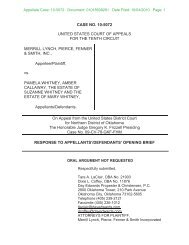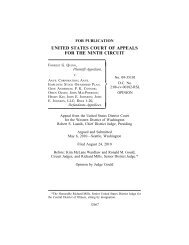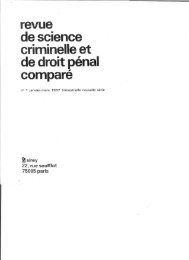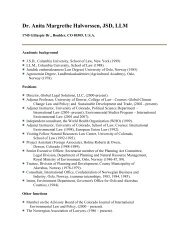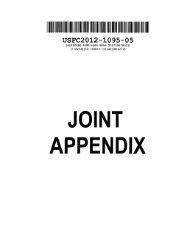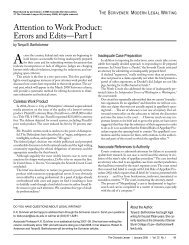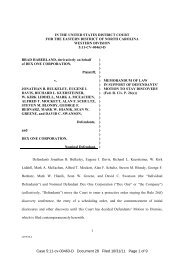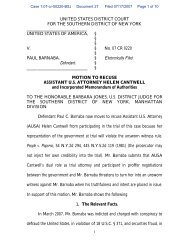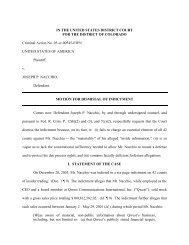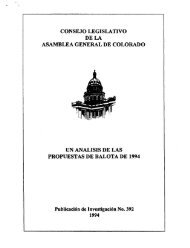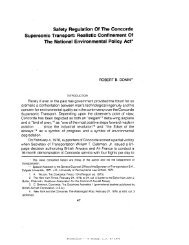SEC v. Huff, No. 11-10758
SEC v. Huff, No. 11-10758
SEC v. Huff, No. 11-10758
Create successful ePaper yourself
Turn your PDF publications into a flip-book with our unique Google optimized e-Paper software.
IN THE UNITED STATES COURT OF APPEALS<br />
FOR THE ELEVENTH CIRCUIT<br />
________________________<br />
<strong>No</strong>. <strong>11</strong>-<strong>10758</strong><br />
________________________<br />
D.C. Docket <strong>No</strong>. 0:08-cv-60315-RSR<br />
<strong>SEC</strong>URITIES & EXCHANGE COMMISSION,<br />
[DO NOT PUBLISH]<br />
FILED<br />
U.S. COURT OF APPEALS<br />
ELEVENTH CIRCUIT<br />
JANUARY 3, 2012<br />
JOHN LEY<br />
CLERK<br />
llllllllllllllllllllllllllllllllllllllll Plaintiff - Appellee,<br />
versus<br />
W. ANTHONY HUFF,<br />
SHERI HUFF, Relief Defendant,<br />
MIDWEST MERGER MANAGEMENT, LLC, Relief Defendant,<br />
llllllllllllllllllllllllllllllllllllllll Defendant -Appellants,<br />
DANNY L. PIXLER, et al.,<br />
________________________<br />
Appeal from the United States District Court<br />
for the Southern District of Florida<br />
________________________<br />
(January 3, 2012)<br />
Defendants.
Before TJOFLAT, MARTIN and HILL, Circuit Judges.<br />
PER CURIAM:<br />
Defendant-Appellant Anthony <strong>Huff</strong> controlled a business scheme that<br />
directed millions of dollars in proceeds from one company, Certified Services, Inc.<br />
(“Certified”), to another company, Midwest Merger Management, LLC<br />
(“Midwest”). The <strong>SEC</strong> filed this civil enforcement action against <strong>Huff</strong>, Sheri<br />
<strong>Huff</strong>, and Midwest after Certified’s collapse. Following a bench trial at which<br />
some of <strong>Huff</strong>’s former business partners testified as <strong>SEC</strong> witnesses, the district<br />
1<br />
court found <strong>Huff</strong> was “the moving force” behind numerous misrepresentations<br />
and omissions in Certified’s <strong>SEC</strong> filings between <strong>No</strong>vember 2002 and <strong>No</strong>vember<br />
2004, and hence liable for five counts of securities law violations. The court also<br />
ordered <strong>Huff</strong> to disgorge $10.017 million, plus interest.<br />
<strong>Huff</strong> argues on appeal that the factual findings underpinning the district<br />
court’s liability determinations were clearly erroneous because of insufficient<br />
evidence. He also claims that the court abused its discretion when it ordered<br />
disgorgement because it relied on erroneous findings of fact and because it<br />
improperly applied the law.<br />
1<br />
The parties consented to proceeding before the magistrate judge in accordance with 28<br />
U.S.C. § 636(c). The magistrate judge’s decisions, which reflect capable work, will be referred<br />
to as those of the district court.<br />
2
This Court may not set aside the district court’s findings of fact unless they<br />
are clearly erroneous. <strong>SEC</strong> v. Carriba Air, Inc., 681 F.2d 1318, 1323 (<strong>11</strong>th Cir.<br />
1982). “Under clear error review, the district court’s determination must be<br />
affirmed ‘so long as it is plausible in light of the record viewed in its entirety.’”<br />
Commodity Futures Trading Comm’n v. Gibraltar Monetary Corp., Inc., 575 F.3d<br />
<strong>11</strong>80, <strong>11</strong>86 (<strong>11</strong>th Cir. 2009). We review “the district court’s findings regarding<br />
the amount of ill-gotten gains to be disgorged for abuse of discretion.” <strong>SEC</strong> v.<br />
Silverman, 328 F. App’x 601, 603 (<strong>11</strong>th Cir. 2009) (citing <strong>SEC</strong> v. Calvo, 378 F.3d<br />
12<strong>11</strong>, 1217–18 (<strong>11</strong>th Cir. 2004)). “The <strong>SEC</strong>’s burden for showing the amount of<br />
assets subject to disgorgement . . . is light: a reasonable approximation of a<br />
defendant’s ill-gotten gains . . . Exactitude is not a requirement.” <strong>SEC</strong> v. ETS<br />
Payphones, Inc., 408 F.3d 727, 735 (<strong>11</strong>th Cir. 2005) (quotation marks omitted).<br />
Upon a thorough review of the briefs and the district court’s findings of<br />
fact, and with the benefit of oral argument, we conclude that <strong>Huff</strong> has not carried<br />
his heavy burden of showing either clear error or an abuse of discretion. In light<br />
of the record viewed as a whole, the district court’s findings that <strong>Huff</strong> reviewed<br />
and approved the <strong>SEC</strong> filings and was the moving force behind the filings’<br />
misrepresentations and omissions is wholly plausible. Under clear error review,<br />
we therefore must affirm <strong>Huff</strong>’s liability on Counts I–IV. See Gibraltar Monetary<br />
3
Corp., Inc., 575 F.3d at <strong>11</strong>86. Similarly, we hold that the district court did not<br />
clearly err in finding that <strong>Huff</strong> “had the requisite power to directly or indirectly<br />
control or influence the specific corporate policy which resulted” in the securities<br />
law violations. Brown v. Enstar Group, Inc., 84 F.3d 393, 396 (<strong>11</strong>th Cir. 1996)<br />
(quotation marks omitted). Accordingly, under Section 20(a) of the Securities<br />
Exchange Act, we affirm <strong>Huff</strong>’s liability on Count V as a “controlling person” of<br />
Certified. See 15 U.S.C. § 78t(a).<br />
Finally, we hold that the district court’s approximation of <strong>Huff</strong>’s ill-gotten<br />
gains was reasonable. The district court adequately supported its finding that the<br />
material misrepresentations of fact and omissions of material fact in the <strong>SEC</strong><br />
filings played a critical role “in allowing <strong>Huff</strong>’s scheme to persist for as long as it<br />
did and in permitting <strong>Huff</strong> to obtain improperly so many millions of dollars from<br />
Certified.” Beyond this, in cases such as this one where the record shows the<br />
fraud to have been “pervasive,” we cannot say it was an abuse of the district<br />
court’s broad discretion to order that the profits associated with the fraudulent<br />
scheme be disgorged. See Commodity Futures Trading Comm’n v. British Am.<br />
Commodity Options Corp., 788 F.2d 92, 93–94 (2d Cir. 1986) (holding that where<br />
fraud is “pervasive,” disgorgement of “all” profits is warranted). <strong>Huff</strong> attacks the<br />
precise figure calculated by the district court, but in doing so, he forgets that<br />
4
“[e]xactitude” in this context “is not a requirement.” ETS Payphones, 408 F.3d at<br />
735. For this reason, we affirm the district court’s disgorgement order.<br />
AFFIRMED.<br />
5



